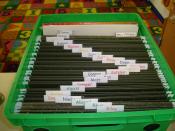 As we continue to review “Literacy Beginnings” (Fountas & Pinnell) as part of the Book Study Blog Party – we will now look at ways to assess writing behaviors in young children.
As we continue to review “Literacy Beginnings” (Fountas & Pinnell) as part of the Book Study Blog Party – we will now look at ways to assess writing behaviors in young children.
Similar to observing reading behaviors, teachers can observe writing behaviors by watching children in shared, interactive and independent writing activities.
Shared/Interactive Writing
Shared and interactive writing is when teachers and children write a story, poem or book together. In shared writing, the teacher does the writing with contributions from the children. Interactive writing allows for the children to do some of the writing (maybe writing a letter or word).
Shared/interactive writing activities are done as a group, but teachers can still observe individual children to assess their level of understanding. As with observing reading behaviors, a teacher can plan to observe 3-4 children a day.
On page 213, the authors list some behaviors to notice when observing a child participate in a shared/interactive writing activity. Here are a few of the behaviors from that list –does the child:
• Show that they know the routine of shared/interactive writing?
• Contribute ideas for sentences?
• Suggest understandable sentences?
• Look at the print while rereading the message as it is being constructed?
Independent Drawing , Writing and Bookmaking
Children in a preschool environment come home with many drawings and early writing markings throughout the school year. Some go on the fridge, and some are recycled or thrown out. Teachers take the time to see the learning behind the marks! Taking or photocopying samples of children’s work throughout the year can show a clear progression from marks on the page to eventually letters and words.
Using a notecard/clipboard system, teachers can observe and note specific behaviors when it comes to children’s drawing and writing. On page 213, some items the authors suggest looking for are:
• does the child appear eager to draw or write
• does the child talks about his/her drawings or writing in an understandable way
• does the child experiment with all kinds of marks on the page to represent writing
• does the child “read” the story that they wrote
Bookmaking takes the children’s literacy understanding to the next level. When observing a child making a book, the authors suggest asking some of the following questions (page 214:
• Are the ideas in the book connected in some way?
• Do the illustrations represent meaning?
• Is the child intentional about what is being represented on the pages?
• How does the book sound when the child “reads” it?
• How long did the child remain attentive while working on the book?
Assessments
The authors state that assessments shouldn’t involve a lot of extra work or take a teacher’s time away from the children. They again suggest using a simple system, like index cards or a clipboard with assessment questions you select . I put together a simple Writing Behaviors clipboard assessment sheet (to assess 3 children at a time), with a fillable form version as well.
Keeping samples of a child’s writing work throughout the year is a great way watch a child’s progression along the writing continuum. There are many ways to store these samples, and again – we want something quick and efficient. One simple method to store samples children’s work is using a crate and file system.
We have used this system at my school for many other uses (such as parent-teacher communications). But this will work very well to store a child’s writing and drawing samples – as it is a quick way for a teacher to file them, rather than taking extra the time to put them in a binder or 2 pocket folder. Simply label each hanging folder with the child’s name, put them in alphabetically order and you are good to go! Take it a step further and ask children to file their OWN work when they have completed it. This saves the teacher time, and also gives the child some independence and MORE practice with literacy by having to find their name. They also learn to recognize their friends names, as well.
What methods to YOU use to for storing and assessing children’s work?
To get more indepth descriptions of writing experiences, such as shared/interactive writing and bookmaking, refer to the following chapter reviews:
• Pre-K Pages – Chapter 5
• PreKinders (Chapter 16)
• Growing in PreK (Chapter 17)
Check back next week for reviews of the last 2 chapters in this section. The first one will be about observing children for evidence of sound, letter and word knowledge.
Grab the button below:



Leave a Reply